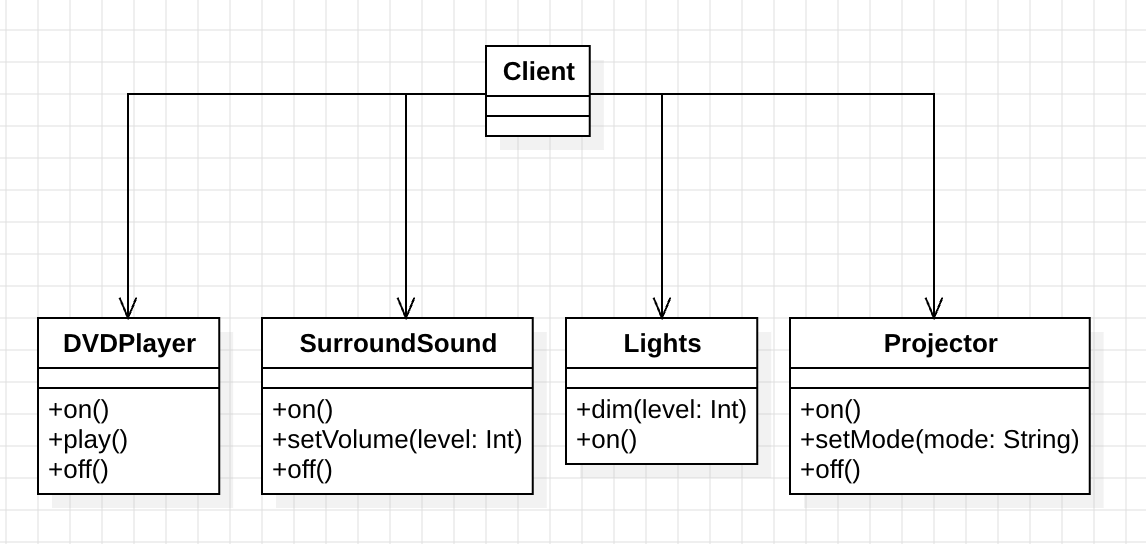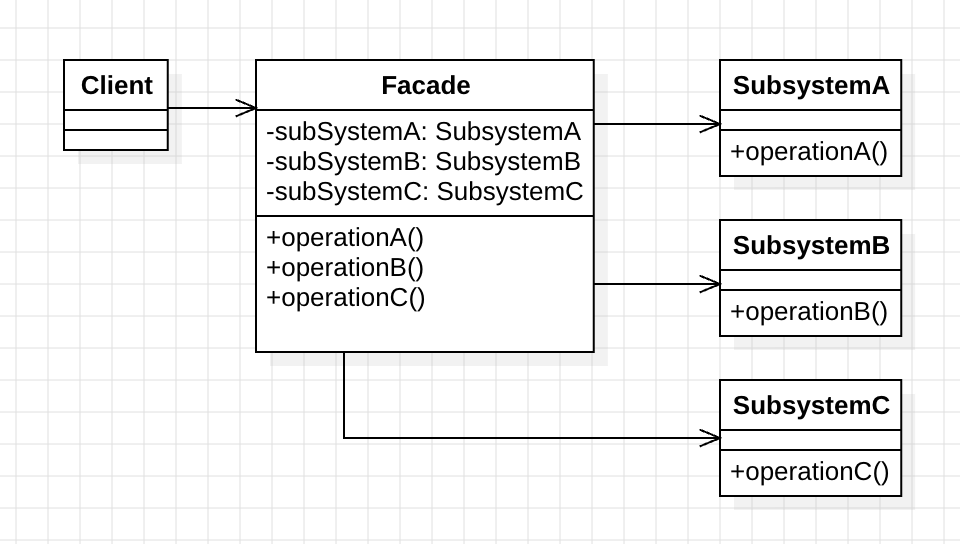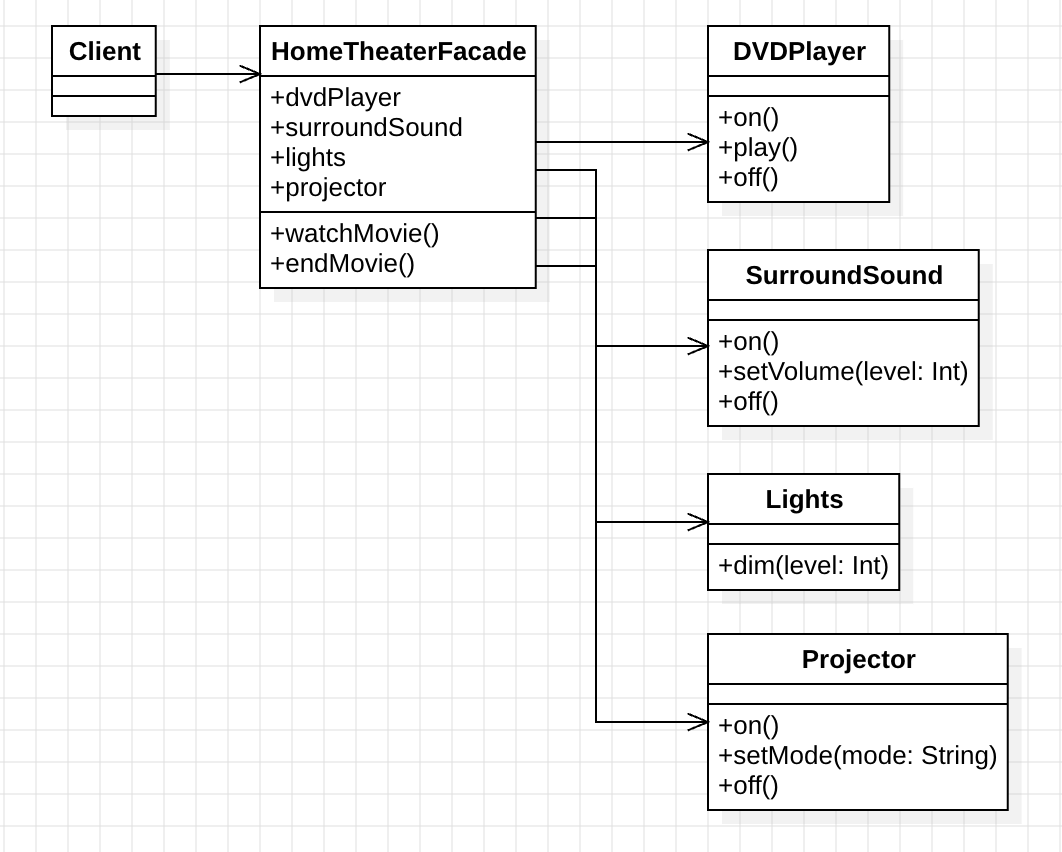Design Pattern (15) Facade Pattern: Unified Interface Design and System Integration Guide
You can download the Design Pattern series code from this design_pattern repo.
After learning the Adapter Pattern, Bridge Pattern, Composite Pattern, and Decorator Pattern, we have mastered the core essence of structural patterns. Now let’s learn an important structural pattern: Facade Pattern, which will provide us with a complete solution for unified interface design in structural pattern learning.
Requirements
We need to develop a unified control interface for a modern home theater system. This high-end audio-visual system consists of multiple sophisticated subsystems.
System Components:
- DVD Player: Handles media playback functionality
- Surround Sound System: Provides high-quality audio effects
- Smart Lighting System: Adjusts lighting ambiance for different scenarios
- HD Projector: Provides theater-grade visual experience
User Requirements:
- One-Click Operation: Users want to turn the entire theater system on or off with a single command
- Simplified Interface: No need to understand complex configurations and operation steps of individual subsystems
- Unified Control: No need to switch between various independent controllers
Technical Challenges:
- Complexity: Each subsystem has its own initialization and configuration steps
- Dependencies: Subsystems may have startup sequence dependencies
- Learning Curve: New users need to learn multiple different operation interfaces
Object-Oriented Analysis (OOA)
Before starting the design, let’s first analyze the core components and usage scenarios in the home theater system:

Identifying Forces
When dealing with this type of multi-subsystem integration complexity, without using appropriate design patterns, we face the following key challenges:
1. Complexity Explosion
Problem Scale:
- To properly start the home theater, users need to execute 8-12 different steps in a specific order
- Each subsystem has 3-5 different configuration points and parameters
- Shutdown steps need to be performed in reverse order, adding to operation complexity
Concrete Impact:
- Users need to remember numerous operation steps and parameters
- Incorrect operations may lead to inconsistent system states
2. High Learning Curve
Problem Description:
- Users need to separately learn how to use DVD player, audio system, lighting, and projector
- Each subsystem has different interface designs and interaction logic
- Cannot quickly get started, affecting user experience
Concrete Impact:
- New users need to spend significant time learning system usage
- Inconsistent usage among family members causes confusion
3. Error Accumulation Risk
Problem Description:
- Manual multi-step operations are prone to errors at any step
- Errors in different subsystems may affect each other, creating chain reactions
- Lack of unified error handling mechanisms
Concrete Impact:
- System may fall into inconsistent states with partial startup
- Troubleshooting becomes complex and time-consuming
4. Dependency Management Difficulties
Problem Description:
- Complex dependencies exist between subsystems
- Modifying one subsystem may affect multiple other subsystems
- Users need to understand these internal dependencies
Concrete Impact:
- High system extension and maintenance costs
- Adding new features may break existing workflows
Applying Facade Pattern (Solution) to Achieve New Context (Resulting Context)
Facing the complexity challenge of multi-subsystem integration, the Facade Pattern provides us with a simple yet powerful solution.
Core Philosophy of Facade Pattern
The essence of Facade Pattern is “encapsulating complexity, providing simple interfaces”. Its main ideas include:
- Unified Entry Point: Provide a simple, consistent operation interface for complex subsystems
- Complexity Encapsulation: Hide dependencies and interaction details between subsystems
- Intelligent Coordination: Automatically manage startup sequences and mutual coordination between subsystems
Real-Life Analogy
Imagine using remote controls:
- Traditional Way: You need to use 4 different remote controls to separately control TV, audio, air conditioning, and lighting
- Facade Way: A smart remote with a “Movie Mode” button that adjusts all devices to optimal state with one click
UML Structure of Facade Pattern
Let’s first understand the structural design of the Facade Pattern:

Core Components of Facade Pattern:
1. Subsystems (Subsystem Collection)
- Represents multiple independent subsystems in the system, each providing specific functionality
- They can collaborate with each other but can also operate independently
- In our example:
DVDPlayer,SurroundSound,Lights,Projector
2. Facade (Facade Class)
- Provides a unified, simplified interface to encapsulate subsystem complexity
- Responsible for coordinating and managing interactions between multiple subsystems
- Selectively combines subsystem functionalities into higher-level convenient operations
- In our example:
HomeTheaterFacade
Differences from Other Structural Patterns:
- vs Adapter: Both handle interface concerns, but Facade simplifies without conversion
- vs Decorator: Both change object behavior, but Facade combines multiple objects into one
- vs Composite: Both handle multiple components, but Facade doesn’t emphasize tree structures
Applying to Our Home Theater
Now let’s apply the Facade Pattern to the home theater system:

Object-Oriented Programming (OOP)
Now let’s implement this Facade Pattern design using Kotlin. We’ll start with the subsystems and gradually build the entire home theater system:
1. Subsystems - Subsystem Collection
First define various independent subsystems, each with its own specialized functionality:
class DVDPlayer {
fun on() = println("DVD Player is ON")
fun play() = println("DVD Player is playing")
fun off() = println("DVD Player is OFF")
}
class SurroundSound {
fun on() = println("Surround Sound is ON")
fun setVolume(level: Int) = println("Surround Sound volume set to $level")
fun off() = println("Surround Sound is OFF")
}
class Lights {
fun dim(level: Int) = println("Lights dimmed to $level%")
fun on() = println("Lights are ON")
}
class Projector {
fun on() = println("Projector is ON")
fun setMode(mode: String) = println("Projector set to $mode mode")
fun off() = println("Projector is OFF")
}
2. Facade - HomeTheaterFacade
Now create the facade class, which will encapsulate all complex operations of the subsystems:
class HomeTheaterFacade(
private val dvdPlayer: DVDPlayer,
private val surroundSound: SurroundSound,
private val lights: Lights,
private val projector: Projector
) {
fun watchMovie() {
println("Get ready to watch a movie...")
lights.dim(10)
projector.on()
projector.setMode("Cinema")
surroundSound.on()
surroundSound.setVolume(5)
dvdPlayer.on()
dvdPlayer.play()
}
fun endMovie() {
println("Shutting down the home theater...")
dvdPlayer.off()
surroundSound.off()
projector.off()
lights.on()
}
}
Client Usage Example
Now let’s see how to use the Facade Pattern to simplify the home theater system usage:
fun main() {
val dvdPlayer = DVDPlayer()
val surroundSound = SurroundSound()
val lights = Lights()
val projector = Projector()
val homeTheater = HomeTheaterFacade(dvdPlayer, surroundSound, lights, projector)
// The Start
homeTheater.watchMovie()
println()
// The End
homeTheater.endMovie()
}
[Output]
Get ready to watch a movie...
Lights dimmed to 10%
Projector is ON
Projector set to Cinema mode
Surround Sound is ON
Surround Sound volume set to 5
DVD Player is ON
DVD Player is playing
Shutting down the home theater...
DVD Player is OFF
Surround Sound is OFF
Projector is OFF
Lights are ON
Execution Results and Analysis
When we execute the above code, we get the following output:
Get ready to watch a movie...
Lights dimmed to 10%
Projector is ON
Projector set to Cinema mode
Surround Sound is ON
Surround Sound volume set to 5
DVD Player is ON
DVD Player is playing
Shutting down the home theater...
DVD Player is OFF
Surround Sound is OFF
Projector is OFF
Lights are ON
This result perfectly demonstrates the power of the Facade Pattern:
- Startup Process: One
watchMovie()call automatically completes 6 different subsystem configurations - Shutdown Process: One
endMovie()call automatically completes proper shutdown of 4 subsystems - Consistent Order: All operations execute in the correct sequence, avoiding manual operation errors
Conclusion
By applying the Facade Pattern, we successfully solved all challenges of multi-subsystem integration:
Core Benefits Achieved:
1. Dramatically Simplified Operation Complexity
- Reduced from 10+ manual operations to 1-step one-click operation
- Users no longer need to remember complex operation sequences and parameters
- Completely eliminated manual operation error risks
2. Enhanced System Usability
- Reduced learning costs, newcomers can get started quickly
- Provided consistent user experience, reducing user confusion
- Enhanced system professionalism and reliability
3. Elegant Architectural Design
- Encapsulated complex dependencies between subsystems
- Provided clear responsibility division: subsystems handle specific functions, Facade handles coordination
- Easy to maintain and extend, modifying subsystems doesn’t affect clients
4. Advanced Intelligent Possibilities
- Facade can incorporate advanced business logic (scenario modes, personalized configurations, etc.)
- Can integrate error handling, logging, performance monitoring and other advanced features
- Provides structured foundation for future AI control and voice interaction
Practical Application Scenarios:
Facade Pattern is particularly useful in:
- System Integration: Integrating multiple third-party APIs or legacy systems
- Microservice Architecture: Providing unified BFF (Backend for Frontend) services for frontends
- SDK Design: Providing simplified library interfaces for developers
- Enterprise Systems: Encapsulating complex internal systems into simple business operations
Structural Pattern Learning Summary:
So far, we have completed learning all five important structural design patterns:
- Adapter Pattern: Solving interface incompatibility problems
- Bridge Pattern: Solving complexity of multi-dimensional changes
- Composite Pattern: Solving unified operations on tree structures
- Decorator Pattern: Solving dynamic feature extension needs
- Facade Pattern: Solving complexity of multi-subsystem integration
These five patterns form a complete structural design pattern toolkit, providing us with powerful tools to handle various structural design challenges. These patterns complement each other and can address most structural design needs in the real world.
Series Navigation
Structural Design Pattern Series
- Adapter Pattern - Making incompatible interfaces work together
- Bridge Pattern - Separating abstraction from implementation, supporting independent evolution
- Composite Pattern - Uniformly handling individual objects and object combinations
- Decorator Pattern - Dynamically adding object functionality without modifying structure
- Flyweight Pattern - Efficiently managing memory usage of large numbers of similar objects
- Proxy Pattern - Controlling resource access through smart proxy objects
Behavioral Design Pattern Series
- Chain of Responsibility Pattern - Building dynamic request handling chains
- Command Pattern - Encapsulating requests as objects to implement undo/redo
Creational Design Pattern Basics
- Singleton Pattern - Ensuring a class has only one instance
- Design Principles - Mastering SOLID principles and design foundations
Through the Facade Pattern, we learned how to simplify access to complex subsystems through unified interfaces. In the next article on the Flyweight Pattern, we will explore techniques for efficiently managing memory usage of large numbers of objects.
Enjoy Reading This Article?
Here are some more articles you might like to read next: